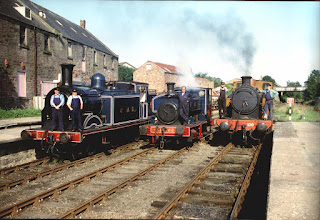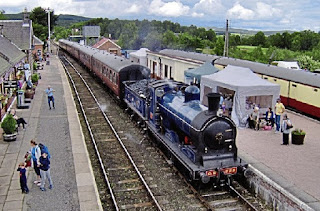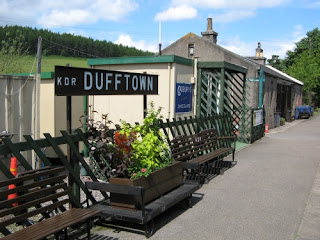https://www.strathspeyrailway.co.ukThe Strathspey Railway (SR) in Badenoch and Strathspey, Highland, Scotland, operates a 10 miles (16 km) heritage railway from Aviemore to Broomhill, Highland via Boat of Garten, part of the former Inverness and Perth Junction Railway (later part of Highland Railway) which linked Aviemore with Forres. It is one of only a handful of primary/secondary main lines to be preserved in Britain today. The Strathspey Railway operates from platform 3 of Network Rail's Aviemore railway station. Until 1998 the railway's southern terminus was Aviemore Speyside about 300 yards further north. Aviemore Speyside is no longer in regular use, although its platform has been retained as a fall back in case of problems with access to the Network Rail station. Coaling of the steam locomotives is carried out at a facility constructed in 2014 on the site of the former Aviemore Speyside station building. Its signal box, which was formerly at Garve West and transported from there in 1986, was retained when the station itself shut. New features are gradually being brought into service at the Aviemore site controlled using traditional British Railways mechanical semaphore signalling.
The Strathspey Railway’s long term ambition has always been to re-open its line all the way from Aviemore to Grantown-on-Spey, fulfilling the vision of those who opposed the line’s closure in the 1960s and those who backed its re-birth. The Strathspey Railway Charitable Trust was established by the railway to deliver this goal by extending the line from its present northern terminus (Broomhill) through to Grantown-on-Spey. The service is due to reopen in line with current guidance from 21st May.
Deeside Railway
https://deeside-railway.co.uk
The Royal Deeside Railway is a standard gauge steam and diesel hauled heritage railway, in a beautiful setting running alongside the River Dee. The line is currently about one mile long and the return journey lasts about 15 to 20 minutes. The original Deeside Railway opened on 8th September 1853 and reached Ballater some 13 years later. It amalgamated with the Great North of Scotland Railway in 1876. The line was regularly patronised by the Royal Family and other visitors to Balmoral Castle until it closed in 1966 as a result of the notorious Beeching Report. Thirty years later, the Royal Deeside Railway Preservation Society was formed and the work of restoring part of the line commenced in 2003. Although they only have about a mile of track in passenger service and are gradually extending the line along the original track bed until reaching Banchory, which will give a running line of just over two miles.
Historically speaking the Deeside Railway was a passenger and goods railway between Aberdeen and Ballater in Aberdeenshire, Scotland. Opening in 1853 to Banchory, an extension reached Aboyne in 1859. A separate company, the Aboyne & Braemar Railway, built an extension to Ballater and this opened in 1866. By 1855 there were five services a day over the 43+1⁄4-mile (69.6 km) long line, taking between 1 hour 50 minutes and 2+1⁄2 hours. The line was used by the Royal Train for travel to and from Balmoral Castle from 1853 and a special 'Messenger Train' ran daily when the Royal Family was in residence. A group, called Campaign for North East Rail, was launched in April 2021 and is campaigning for the reinstatement of the Deeside Railway between Aberdeen and Banchory seeking to build on the successful reintroduction of the Borders Railway services and promote better services in the Aberdeen region.
Keith and Dufftown Railway
https://keith-dufftown-railway.co.uk
The Keith and Dufftown Railway keeps alive an eleven mile line linking the World’s Malt Whisky Capital, Dufftown, with the historic town of Keith, hence is also know as 'The Whisky Line'. The railway runs for 11 miles (18 km) from Keith Town, Keith to Dufftown via Drummuir and Auchindachy. Dufftown is the main centre of operation of the railway where there is a booking office, waiting room and cafe called the 'Sidings Cafe', which is open March to November. There are two headshunts and a loop.
Work is being undertaken to install a new loop at Dufftown so that there can be two tracks going into the new engine shed. At Dufftown there are seven working distilleries to its name, Dufftown can argue that the title of "Malt Whisky Capital of the World" is justifiably earned! The town was founded in 1817 by the Earl of Fife to relieve unemployment and the quality of its local water sources saw it develop into a major centre for the distilling industry. Perhaps the most famous of Dufftown's exports is the Glenfiddich which is the only Highland Single Malt to be distilled, matured and bottled on one site. The distillery, which is alongside the railway at Dufftown, has, for five generations, been run by the Grant family and is open to the public throughout the summer.
Caledonian Railway
https://caledonianrailway.com
The Caledonian Railway established for over 170 years is now an entirely volunteer run, non-profit organisation that operates heritage steam and diesel hauled trains along the 4 mile branch line between the town of Brechin and the countryside stop of Bridge of Dun. The railway has been in operating as a preservation society since 1979 and is open on weekends throughout the summer.
 The line has now been re-instated and preserved for 4 miles (6.4 km) between Brechin railway station and Bridge of Dun railway station and since 1993 trains have run at weekends during the summer as well as on special occasions at other times of the year. The two railway stations have also been refurbished. Although the line originally went all the way to Montrose, which is still a station on the main rail network, there are currently no immediate plans to link the Brechin line back into the main rail network, as the section at Dubton through and onto Kinnaber Junction close to Montrose itself has now been redeveloped, making it difficult for the preserved railway to be reconnected to the national network at all. However, there is still hope of seeing the "CR Brechin" extended a further 3 1⁄2 miles (5.6 km) to Dubton, bringing it up to a total of 7 1⁄2 miles (12.1 km) in length. This is a long-term aim which would only require the re-instatement of a short length of track.
The line has now been re-instated and preserved for 4 miles (6.4 km) between Brechin railway station and Bridge of Dun railway station and since 1993 trains have run at weekends during the summer as well as on special occasions at other times of the year. The two railway stations have also been refurbished. Although the line originally went all the way to Montrose, which is still a station on the main rail network, there are currently no immediate plans to link the Brechin line back into the main rail network, as the section at Dubton through and onto Kinnaber Junction close to Montrose itself has now been redeveloped, making it difficult for the preserved railway to be reconnected to the national network at all. However, there is still hope of seeing the "CR Brechin" extended a further 3 1⁄2 miles (5.6 km) to Dubton, bringing it up to a total of 7 1⁄2 miles (12.1 km) in length. This is a long-term aim which would only require the re-instatement of a short length of track.




No comments:
Post a Comment